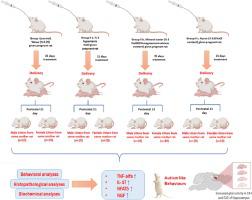Physiology & Behavior ( IF 2.4 ) Pub Date : 2021-08-04 , DOI: 10.1016/j.physbeh.2021.113545 Evrim Senkal 1 , Erman Bagcioglu 2 , Umut Eryigit 3 , Oytun Erbas 4 , Volkan Solmaz 5

|
Objectives
to investigate the effects of hyperosmolar state (HS) on immune response and inflammation via the NFAT5 pathway and examine whether immune-mediated conditions trigger autism-like behavior in offspring.
Methods
a pregnant rat model was performed by administering hyperosmotic solutions. Pregnant rats were divided into 2 main groups; control (group I) and hyperosmolar groups (group II). Control group rats were given % 0.25 NaCI (tap water) (n = 6), the Hyperosmolar (HO) group was further subdivided into 3 groups as; Group II a rats which were given % 3 hypertonic NaCl (n = 6), Group II b rats were given mineral water (% 3 NaHCO3+magnesium+calcium content) (n = 6), and Group II c rats were given Ayran (% 0.8 NaCl content) (n = 6). Their offspring were examined for behaviors, biochemical and histological abnormality.
Results
in offspring, TNF- α, IL-17, NFAT-5, and NGF levels in the brain were significantly higher in hyperosmotic solution groups than in control rats. Exposure of pregnant rats to hyperosmotic solution resulted in autism-like behaviors in their offspring. Through immunohistochemical methods, we found that CA1 and CA2 of the hippocampus indicated decreased number of neurons in hyperosmotic solution groups compared with the control group.
Conclusions
our findings once again emphasized that the immune-mediated conditions involved in the pathophysiology of autism. NFAT5 pathway may be a key factor in the development of neuroinflammation by hyperosmotic solutions.
中文翻译:

怀孕期间暴露于高渗溶液通过 NFAT-5 通路诱导大鼠模型后代的自闭症样行为
目标
研究高渗状态 (HS) 通过 NFAT5 途径对免疫反应和炎症的影响,并检查免疫介导的条件是否会触发后代的自闭症样行为。
方法
通过给予高渗溶液进行怀孕大鼠模型。妊娠大鼠分为2个主要组;对照组(I 组)和高渗组(II 组)。对照组大鼠给予 % 0.25 NaCl(自来水)(n = 6),高渗(H2O)组进一步细分为 3 组:给予 % 3 高渗氯化钠 ( n = 6) 的 II a 组大鼠,给予矿泉水 (% 3 NaHCO3+镁+钙含量) ( n = 6) 的 II b 组大鼠,给予 Ayran ( % 0.8 NaCl 含量)(n = 6)。他们的后代接受了行为、生化和组织学异常检查。
结果
在后代中,高渗溶液组大鼠脑中 TNF-α、IL-17、NFAT-5 和 NGF 水平显着高于对照组。怀孕大鼠暴露于高渗溶液会导致其后代出现类似自闭症的行为。通过免疫组织化学方法,我们发现与对照组相比,高渗溶液组海马CA1和CA2表明神经元数量减少。
结论
我们的研究结果再次强调了免疫介导的疾病与自闭症的病理生理有关。NFAT5 通路可能是高渗溶液引起神经炎症的关键因素。











































 京公网安备 11010802027423号
京公网安备 11010802027423号